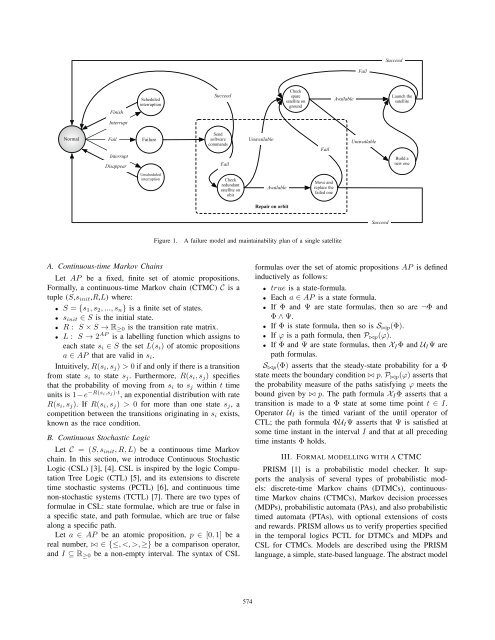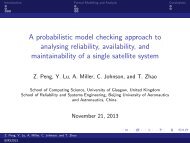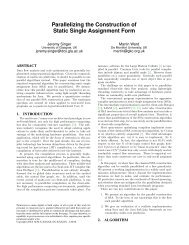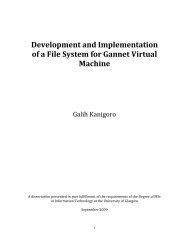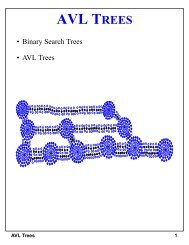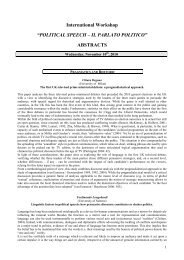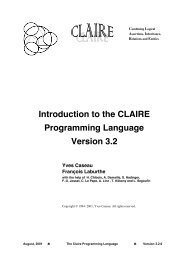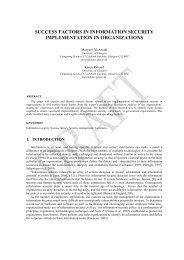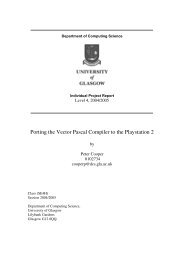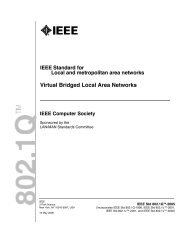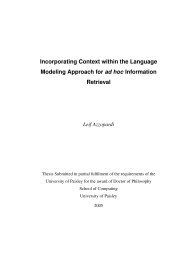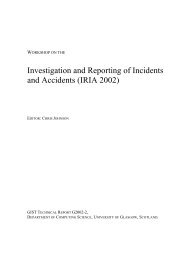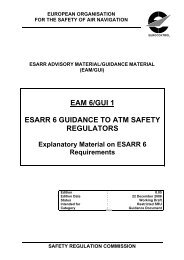A Probabilistic Model Checking Approach to Analysing Reliability ...
A Probabilistic Model Checking Approach to Analysing Reliability ...
A Probabilistic Model Checking Approach to Analysing Reliability ...
Create successful ePaper yourself
Turn your PDF publications into a flip-book with our unique Google optimized e-Paper software.
Succeed<br />
Fail<br />
Finish<br />
Scheduled<br />
interruption<br />
Succeed<br />
Check<br />
spare<br />
satellite on<br />
ground<br />
Available<br />
Launch the<br />
satellite<br />
Interrupt<br />
Normal<br />
Fail<br />
Interrupt<br />
Disappear<br />
Failure<br />
Send<br />
software<br />
commands<br />
Fail<br />
Unavailable<br />
Fail<br />
Unavailable<br />
Build a<br />
new one<br />
Unscheduled<br />
interruption<br />
Check<br />
redundant<br />
satellite on<br />
obit<br />
Available<br />
Move and<br />
replace the<br />
failed one<br />
Repair on orbit<br />
Succeed<br />
Figure 1.<br />
A failure model and maintainability plan of a single satellite<br />
A. Continuous-time Markov Chains<br />
Let AP be a fixed, finite set of a<strong>to</strong>mic propositions.<br />
Formally, a continuous-time Markov chain (CTMC) C is a<br />
tuple (S,s init ,R,L) where:<br />
• S = {s 1 ,s 2 , ..., s n } is a finite set of states.<br />
• s init ∈ S is the initial state.<br />
• R : S × S → R ≥0 is the transition rate matrix.<br />
• L : S → 2 AP is a labelling function which assigns <strong>to</strong><br />
each state s i ∈ S the set L(s i ) of a<strong>to</strong>mic propositions<br />
a ∈ AP that are valid in s i .<br />
Intuitively, R(s i ,s j ) > 0 if and only if there is a transition<br />
from state s i <strong>to</strong> state s j . Furthermore, R(s i ,s j ) specifies<br />
that the probability of moving from s i <strong>to</strong> s j within t time<br />
units is 1−e −R(si,sj)·t , an exponential distribution with rate<br />
R(s i ,s j ).IfR(s i ,s j ) > 0 for more than one state s j ,a<br />
competition between the transitions originating in s i exists,<br />
known as the race condition.<br />
B. Continuous S<strong>to</strong>chastic Logic<br />
Let C = (S, s init ,R,L) be a continuous time Markov<br />
chain. In this section, we introduce Continuous S<strong>to</strong>chastic<br />
Logic (CSL) [3], [4]. CSL is inspired by the logic Computation<br />
Tree Logic (CTL) [5], and its extensions <strong>to</strong> discrete<br />
time s<strong>to</strong>chastic systems (PCTL) [6], and continuous time<br />
non-s<strong>to</strong>chastic systems (TCTL) [7]. There are two types of<br />
formulae in CSL: state formulae, which are true or false in<br />
a specific state, and path formulae, which are true or false<br />
along a specific path.<br />
Let a ∈ AP be an a<strong>to</strong>mic proposition, p ∈ [0, 1] be a<br />
real number, ⊲⊳ ∈{≤,,≥} be a comparison opera<strong>to</strong>r,<br />
and I ⊆ R ≥0 be a non-empty interval. The syntax of CSL<br />
formulas over the set of a<strong>to</strong>mic propositions AP is defined<br />
inductively as follows:<br />
• true is a state-formula.<br />
• Each a ∈ AP is a state formula.<br />
• If Φ and Ψ are state formulas, then so are ¬Φ and<br />
Φ ∧ Ψ.<br />
• If Φ is state formula, then so is S ⊲⊳p (Φ).<br />
• If ϕ is a path formula, then P ⊲⊳p (ϕ).<br />
• If Φ and Ψ are state formulas, then X I Φ and U I Ψ are<br />
path formulas.<br />
S ⊲⊳p (Φ) asserts that the steady-state probability for a Φ<br />
state meets the boundary condition ⊲⊳ p. P ⊲⊳p (ϕ) asserts that<br />
the probability measure of the paths satisfying ϕ meets the<br />
bound given by ⊲⊳ p. The path formula X I Φ asserts that a<br />
transition is made <strong>to</strong> a Φ state at some time point t ∈ I.<br />
Opera<strong>to</strong>r U I is the timed variant of the until opera<strong>to</strong>r of<br />
CTL; the path formula ΦU I Ψ asserts that Ψ is satisfied at<br />
some time instant in the interval I and that at all preceding<br />
time instants Φ holds.<br />
III. FORMAL MODELLING WITH A CTMC<br />
PRISM [1] is a probabilistic model checker. It supports<br />
the analysis of several types of probabilistic models:<br />
discrete-time Markov chains (DTMCs), continuoustime<br />
Markov chains (CTMCs), Markov decision processes<br />
(MDPs), probabilistic au<strong>to</strong>mata (PAs), and also probabilistic<br />
timed au<strong>to</strong>mata (PTAs), with optional extensions of costs<br />
and rewards. PRISM allows us <strong>to</strong> verify properties specified<br />
in the temporal logics PCTL for DTMCs and MDPs and<br />
CSL for CTMCs. <strong>Model</strong>s are described using the PRISM<br />
language, a simple, state-based language. The abstract model<br />
574


